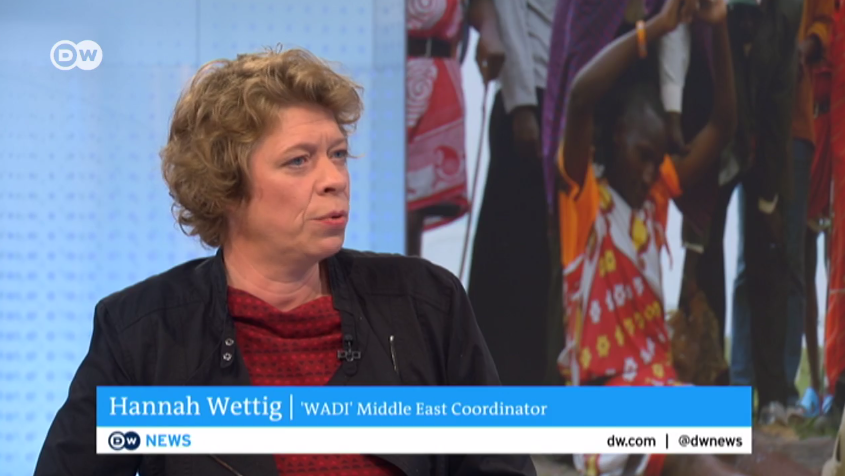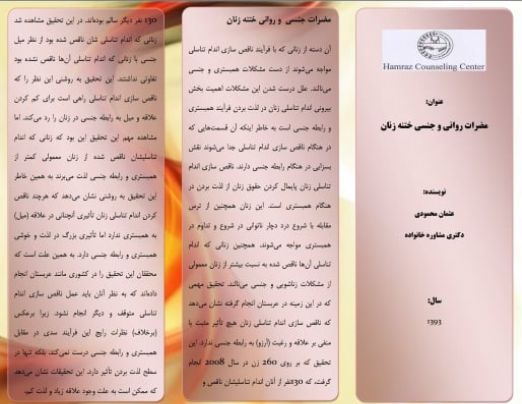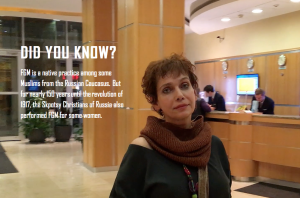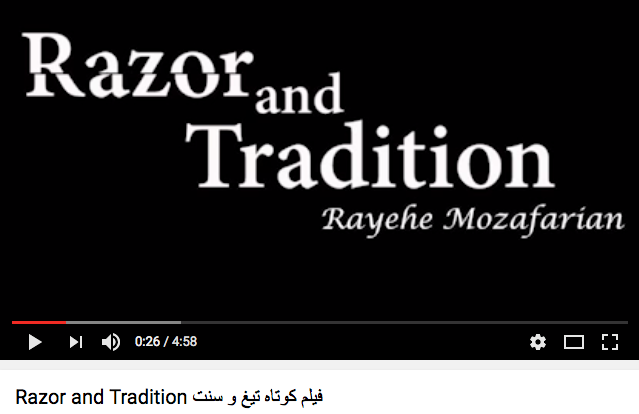Home » Press Statement » Project Updates
Project Updates
Feb 6: Wadi speaks on DW about what made success in Kurdistan possible
6.2.2020 “You need to work with the communities, not against them, said Stop FGM Middle East & Asia campaigner Hannah Wettig on Deutsche Welle TV on February 6th. (more…)
Oman bans unexpectedly Female Genital Mutilation
30.9.2019. Two weeks ago, the Omani Ministry of Social Affairs und Development announced a change in the law protecting children. Now, the convention of the child includes a specific prohibition of female genital mutilation (FGM). This change in law came as a surprise to most observers. (more…)
Study finds: FGM is practiced by Saudi women
In the sample, almost 80 percent of the questioned women were of Saudi origin and only 175 women of the total 963 reported to have undergone FGM. Yet, of these 62,8 percent were Saudi. This is indeed a striking result and shows that further research in Saudi Arabia is needed.
On a positive note, the study found that FGM was more common among older women and that support for the continuation of the practice is low with only 5,3 percent wanting it to continue, while 68,7 percent wanted it to stop. Among the group who had undergone FGM support was higher with 18,3 percent wanting to continue it, yet still low compared to other regions were FGM is common and no awareness campaign has taken place.
Read the study:
Abdulrahim A Rouzi, Rigmor C Berg, Rana Alamoudi, Faten Alzaban, Mohammad Sehlo: Survey on female genital mutilation/cutting in Jeddah, Saudi Arabia, 2019
New Awareness Brochures against FGM distributed in Kurdistan-Iran
20.05.2019 The distribution of the Educational Brochure as a Risk Minimization Activity to raise awareness about FGM complications among residents of Javanrud and Salas.
Educational brochures are an important tool for raise awareness about FGM and its complications among in risk people. It is important to evaluate the impact of any risk minimization tool to understand the effectiveness of the strategy.
The objective of this work was to distribute of a targeted educational brochure among residents cities of Javanrud and Salas (Kermanshah Province) as a risk minimization strategy for the stop FGM in these important regions of Iranian Kurdistan.
Dr. Osman Mahmoudi and his team at Hamraz Counseling Center held a prospective, non-interventional study designed to distribute a special brochure designed to provide important new information on female genital mutilation and its complications to a specific urban population consisting of citizens of Salas and Javanrood in Kermanshah province.
The statistical population in this educational project included all women and girls over 18 years of age in the target cities. During pre-marriage classes in 2018 more than 2000 girls and women over the age of 18 in 15 rural and urban areas of Javanrud and Salas were directly trained by 20 trainers about female genital mutilation and its complications. And more than 2000 leaflets on female genital mutilation and its complications in these 15 urban and rural neighborhoods were distributed by the 20 trainers.
It’s important we noted that all of 20 trainers received advanced training about female genital mutilation and complications by Dr. Osman Mahmoudi prior to training and distribution of brochures. Distribution of targeted educational brochures may be an effective risk minimization strategy to raise awareness about FGM and its complications in Kermanshah; Educational brochures may also be an effective channel for sharing information on how FGM should be best managed and ended. The Campaign of Hamraz Counseling Center is hosted by Dr. Osman Mahmoudi. Over the past ten years, the campaign has been active in research, education, and counseling in the cities of Kermanshah (That women are more likely to be circumcised) in the field of female genital mutilation. If they receive more support for running their programs to stop FGM, these important activities can spread to other cities and provinces of Iran.
FGM Worldwide, It’s Worse Than You Think
25.11.2018. By Dr. John Chua
On the 15th of November, the UK Government hosted the world’s experts on Female Genital Mutilation at an international conference. The keynote speech by the UK’s Home Secretary suggests a celebratory tone in acknowledging the successful reduction of FGM in Africa. Indeed, the UK in 2013 made the most generous commitment ever by a single donor to end FGM, with a focus on Africa, resulting in the successes we see now. While commendable, the primary focus on Africa is not new and has meant many other countries are largely ignored.
In 2008, the UK Border Agency published a list of countries where females are at-risk of being subjected to FGM. With only African countries listed, this was for them an African issue. Migrants from these countries could be subjected to investigations or interrogations by officials regarding FGM.
Among many experts, the dominant theory suggests FGM came from Africa thousands of years ago, was later adopted by some Islamic sects and spreads around the world through migration. In Britain, thousands of FGM cases among migrants are recorded each year although there is yet no successful prosecution and conviction.
But the reality is FGM is not just an African problem. The country with the largest number of FGM survivors and at-risk girls is not even African. It is Indonesia, the world’s most populous Muslim country.
As someone who spent nearly a decade travelling worldwide to investigate and research FGM, the truth about this human rights abuse is worse than you might imagine. I’ve found FGM in the cartel land of Mexico, Russian Caucasus, Peruvian Amazon, war zones in Iraq, cosmopolitan Singapore, and even suburban America. FGM, done for different reasons in each place, is a native practice in every continent, except Antarctica.
My work on FGM began almost by accident when I went to Iraq to train journalists and found the NGO Wadi trying to document FGM exists in Iraqi Kurdistan. The West, then still associating FGM with Africa, was shocked to learn of this.
In Iraq, I partnered with Wadi, and produced a few investigative documentaries for The Guardian and BBC that exposed the extent of this problem in Kurdistan. To their credit, the activists at Wadi played a major role in getting FGM outlawed in Kurdistan, and within a few short years, the majority of Kurdish Iraqis turned against FGM.
In 2013, I thought my job was done. But through Wadi, I met other activists working to end FGM. At first, they were the ones in countries adjacent to Iraq, specifically Iran, Saudi Arabia and Oman. I started interviewing them and eventually, I went further afield, first to Malaysia, then the Pattani region in Thailand, and to Singapore. In all these places, FGM is a taboo subject but through sheer determination I was able to talk to cutters, survivors and activists. In Singapore, I surveyed 116 Muslim women and 86 of them were FGM survivors.
Although I am British, I was born in Singapore and to my dismay, people there I have known most of my life are impacted by FGM. I even recorded video of medical staff in Singapore offering to cut my nonexistent British daughter.
In fact, in many parts of the world, FGM is found in medical settings, with parents erroneously thinking it would be ‘safer’ if done in a clinic. Two years ago a teenage girl died after undergoing FGM in an Egyptian clinic.
In a special report, I met and interviewed a gynaecologist in Dagestan, Russia who truly believes in the medical ‘benefits’ of FGM. In Detroit last year, doctors belonging to the Dawoodi-Bohra Muslim sect were arrested for performing FGM.
But this isn’t new; there is a long history of doctors performing FGM. In the mid-1800s, some British doctors recommended cutting the clitoris to cure many sicknesses. Dr. Isaac Baker Brown, the president of the Medical Society of London, published his 1866 treatise On the Curability of Certain Forms of Insanity, Epilepsy, Catalepsy, and Hysteria in Females, prescribing clitoridectomy for a number of illnesses.
These ideas took hold in the United States for a number of decades, well into the twentieth century. While American families would generally not talk about female genital cutting and the exact number of such operations is unknown, there is ample evidence that some white Christian women were subjected to FGM.
For nearly a century, American medical texts and doctors taught female circumcision and clitoridectomy and Christian books make positive reference to the procedure as a cure for masturbation, even as late as the 1960s. One such book by a former dean of a medical school is still for sale on a church’s website.
I managed to track down a white Christian FGM survivor and convinced her to go public with her story. For many decades Dr. Rene Bergstrom kept her story a secret, afraid that publicising it would upset her family. (Her mother, concerned that she was masturbating, found a doctor to cut her when she was three.)
Together we released her story first at The Guardian and then later as the main subject in a short film, which won a prize on PBS’s To The Contrary and aired across the United States in late 2017. After the TV broadcast, a few white Christian FGM survivors contact us. Like Renee, all of them thought they were alone in having survived FGM, as they have never heard about it happening to any other white people they know.
In the Americas, FGM is not just in the United States. The Emberás of Panama and Colombia practice FGM. We would not have known about it had not the death of young girls from the cutting in 2007 caught the attention of the wider world.
As explained in an interview I conducted with an Emberá activist and with the UN in Colombia, they believed that cutting the clitoris would prevent it from becoming a penis. Furthermore, one prevailing theory is that African slaves bought the cutting tradition to the new world.
But I’m suspicious of this out-of-Africa theory and as I discovered, FGM is also found among many other tribes in Colombia. How could African slaves have influenced such a large area of the country? FGM is indigenous to South America and I found the proof in Amazonian Peru.
For centuries the Shipibo tribe had elaborate ceremonies celebrating the genital cutting of teenage girls. While these practices have stopped in recent years, the artefacts used for the cutting have been radiocarbon dated to a time before the arrival of Columbus. Meanwhile other South American tribes like the Secoya and Kaxinawá reportedly still practice FGM, and their remote locations make outreach and studies difficult.
Recently I have completed a feature length documentary by combining all the footage I have shot around the globe. But my research is incomplete; it will take many more people to comprehensively investigate and document FGM worldwide.
For example, I have heard a story that some Nahuas in Mexico cut the genitals of young girls. This remains to be proven. But in Juárez, Mexico for the last two decades, cartel serial killers kidnap young women and after sexual and genital mutilation, dump their bodies as a warning to others.
Hundreds if not thousands of women have been killed. Despite the arrests and convictions of the supposed killers, the femicide continues. On a recent visit to Juárez, I saw first hand how the missing women impact the psyche of the city.
After watching masked police officers patrol Juárez’s streets and seeing arrests on street corners in the ‘war on drugs’, I read that in many parts of Mexico, the authorities are accused of torturing arrested women with electric shocks to their genitals, which could cause burns which fit Type IV FGM. Clearly FGM is used to instil fear in the population.
Just a few years ago, FGM experts and friends felt my attempt to document FGM around the world was a fool’s errand. I can’t explain why I did it, as I never expected to come this far.
But I’ve learned this. While FGM is found across many ethnic groups and religions, with each assigning a different ‘reason’ for its practice, underneath their irrational explanations lie a universal mad urge to control the female body, sexuality and behaviour.
Formulating government policies to end FGM require knowledge of the facts and sadly, there is still so much the world doesn’t know about FGM. I suspect the UK will continue to focus primarily on ending FGM in Africa or where they might realistically achieve the best results. I simply can’t imagine the British Government stepping in to stop FGM in places like southern Iraq or even friendly countries such as Oman or Singapore.
But as I have also learned in northern Iraq, it takes individuals standing up to end this scourge. You could very well be situated close to someone affected by FGM. It takes all of us exposing FGM globally to end it.
Dr. John Chua’s feature film Cut: Exposing FGM Worldwide screens at Terre des Femmes Film Festival in Germany on 24th of November, ahead of its global release by Gravitas Ventures, the film distribution subsidiary of the German TV network ProSiebenSat.1.
Wadi talks on Deutsche Welle about FGM in Asia
27.8.2018 The German women’s rights organization Terre des Femmes just came out with new figures about female genital mutilation (FGM): More than 65.000 women and girls are cut in Germany, 12 percent more than the last estimate. This rise is mainly due to an influx of refugees from Somalia, Eritrea and Iraq in recent years. Deutsche Welle TV spoke with WADI on the news in it’s English and German program about FGM in Iraq and Asia. 
Hormozgan, Iran: Meetings with scholars on FGM
26.10.2017. By Rayehe Mozafarian
After numerous reports on FGM in Hormozgan by various associations and publishing materials, finally one of the provincial governors of Hormozgan acknowledged the problem and announced to act:
Director General of the Office of Social and Cultural Affairs of Hormozgan Governorate has stated that we will have meetings with scholars on FGM of girls. (more…)
Ending Female Genital Mutilation among Kurds: Couple Approach in Iranian Journal
7.6.2017. By Osman Mahmoudi
Despite some successes in ending FGM among Kurdish people in Iran the rate of abandonment has been slow. Based on Osman Mahmoudi’s and Elham Houseini’s study on Psychosexual complications of Female Genital Mutilation for couples, published recently in the Journal of Kermanshah University of Medical Sciences, the couple developed now a new approach to the abandonment of FGM. The Osman Project (OP), named after the reseacher and initiatator of nongovernmental activities that promote mental health and development of women and girls in Uramanat region of Kermanshah province, started in 2010 in Javanroud, and later in Salas, Paveh, and Ravansar. OP’s main goal was to overcome the negative biases against couples and instead involve these couples in community efforts to improve the health and well-being of women and children. (more…)
Survey: Majority of religious leaders pro FGM in Kermansheh, Iran
11.8.2016. By Stop FGM Middle East. A recent survey among Sunni religous scholars in the Iranian province of Kermansheh shows that a majority of them (67%) believe that “female circumcision” is religiously obligatory or at least recommended for girls and women. In this province in the West of Iran, female genital mutilation (FGM) is practiced by Sunni Kurds who adhere to the Shafi’i law school. Many of them believe that Islam commands them to have their girls cut. (more…)










